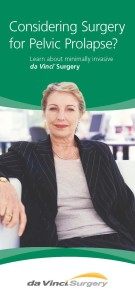da Vinci® Sacrocolpopexy
da Vinci® Pelvic Prolapse Surgery
Your Doctor may recommend surgery if your symptoms from pelvic prolapse are severe and affect your lifestyle. Prolapse surgery is also known as sacrocolpopexy, which is a surgical technique for repairing pelvic organ prolapse. Usually for women who have had a previous hysterectomy. It is designed to restore the vagina to its normal position and function.
80-90% of women having sacrocolpopexy have been successfully cured of their prolapse.
Why da Vinci® Surgery?
You may be a candidate for da Vinci Sacrocolpopexy, if you are facing pelvic prolapse surgery. With the da Vinci System, surgeons achieve reconstruction through an abdominal small incision in the belly button or through a few small incisions instead of a long, large open incision. The da Vinci System uses miniature wristed instruments that bend and rotate to a greater degree than the human wrist. This provides your surgeon with a 3D High-Definition view inside your body.
Pelvic Prolapse Treatment Benefits
As a result of da Vinci technology, da Vinci Sacrocolpopexy offers the following potential benefits when compared to traditional open surgery:
- Less blood loss1,2,3
- Shorter hospital stay1,2,3
- Small incisions for minimal scarring
As a result of the da Vinci technology, da Vinci Sacrocolpopexy offers the following potential benefits compared to traditional laparoscopy:
- Shorter operation4
- Less blood loss4
- Shorter duration with catheter4
Additional potential benefits of da Vinci Sacrocolpopexy include:
- Low rate of complications5,6
- High sexual function5
- Improved urinary, bowel, and pelvic symptoms5
Medical Robots
State-of-the-art da Vinci uses modern surgical and robotics technology for routine and complex procedures. Your doctor is in full control, the da Vinci System, cannot move on its own without with out the surgeon. The system exchanges their hand movements into smaller, more precise movements of small instruments inside your body.
Prolapse Surgery Miami
Physicians have used the da Vinci System successfully worldwide in more than 1 million patients to date. da Vinci is changing the experience of surgery for patients around the globe.
Risks & Considerations Related to Sacrocolpopexy & da Vinci Surgery
Potential risks of any sacrocolpopexy procedure, including da Vinci Surgery, include:
- Bowel blockage2
- Painful urination4
- Urinary infection4
PN 1002187 Rev B 01/2014
- Geller EJ, Siddiqui NY, Wu JM, Visco AG. Short-term outcomes of robotic sacrocolpopexy compared with abdominal sacrocolpopexy. Obstetrics & Gynecology. 2008;112:1201–6.
- Siddiqui NY, Geller EJ, Visco AG. Symptomatic and anatomic 1-year outcomes after robotic and abdominal sacrocolpopexy. Am J Obstet Gynecol. 2012 May;206(5):435.e1-5. Epub 2012 Feb 1.
- Hoyte L, Rabbanifard R, Mezzich J, Bassaly R, Downes K. Cost analysis of open versus robotic-assisted sacrocolpopexy. Female Pelvic Med Reconstr Surg. 2012 Nov-Dec;18(6):335-9. doi: 10.1097/SPV.0b013e318270ade3.
- Seror J, Yates DR, Seringe E, Vaessen C, Bitker MO, Chartier-Kastler E, Rouprêt M. Prospective comparison of short-term functional outcomes obtained after pure laparoscopic and robot-assisted laparoscopic sacrocolpopexy. World J Urol. 2012 Jun;30(3):393-8. Epub 2011 Aug 20.
- Geller EJ, Parnell BA, Dunivan GC. Pelvic floor function before and after robotic sacrocolpopexy: one-year outcomes. J Minim Invasive Gynecol. 2011 May-Jun;18(3):322-7. Epub 2011 Apr 1.
- Elliott DS, Krambeck AE, Chow GK. Long-term results of robotic assisted laparoscopic sacrocolpopexy for the treatment of high grade vaginal vault prolapse. J Urol. 2006 Aug;176(2):655-9.
Serious complications may occur in any surgery, including da Vinci® Surgery, up to and including death. Examples of serious or life-threatening complications, which may require prolonged and/or unexpected hospitalization and/or reoperation, include but are not limited to, one or more of the following: injury to tissues/organs, bleeding, infection and internal scarring that can cause long-lasting dysfunction/pain. Risks of surgery also include the potential for equipment failure and/or human error. Individual surgical results may vary.
Risks specific to minimally invasive surgery, including da Vinci Surgery, include but are not limited to, one or more of the following: temporary pain/nerve injury associated with positioning; temporary pain/discomfort from the use of air or gas in the procedure; a longer operation and time under anesthesia and conversion to another surgical technique. If your doctor needs to convert the surgery to another surgical technique, this could result in a longer operative time, additional time under anesthesia, additional or larger incisions and/or increased complications.
Patients who are not candidates for non-robotic minimally invasive surgery are also not candidates for da VinciSurgery. Patients should talk to their doctor to decide if da Vinci Surgery is right for them. Patients and doctors should review all available information on non-surgical and surgical options in order to make an informed decision. For Important Safety Information, including surgical risks, indications, and considerations and contraindications for use, please also refer to www.davincisurgery.com/safety and www.intuitivesurgical.com/safety. Unless otherwise noted, all people depicted are models.




